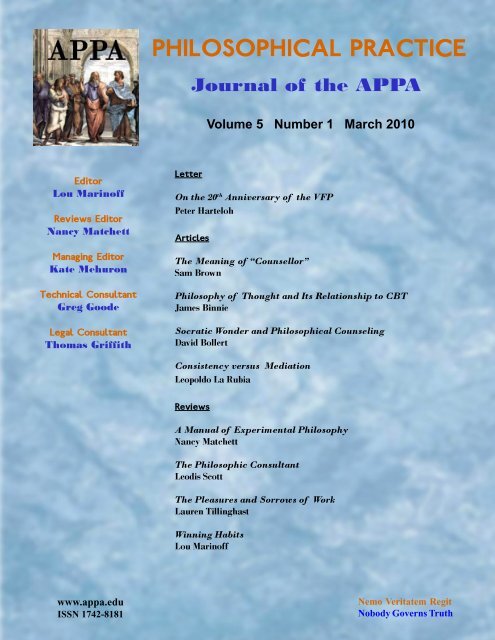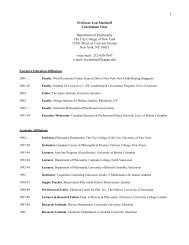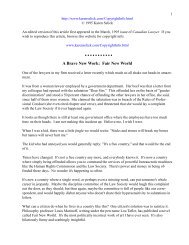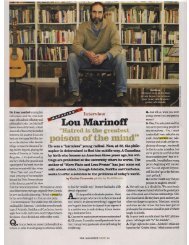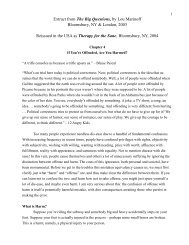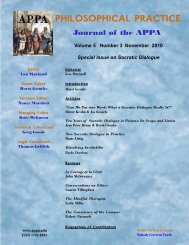Winning Habits: Techniques for Excellence in Sports ... - Lou Marinoff
Winning Habits: Techniques for Excellence in Sports ... - Lou Marinoff
Winning Habits: Techniques for Excellence in Sports ... - Lou Marinoff
You also want an ePaper? Increase the reach of your titles
YUMPU automatically turns print PDFs into web optimized ePapers that Google loves.
599PHILOSOPHICAL PRACTICEJournal of the APPAVolume 5 Number 1 March 2010Editor<strong>Lou</strong> Mar<strong>in</strong>offReviews EditorNancy MatchettManag<strong>in</strong>g EditorKate MehuronTechnical ConsultantGreg GoodeLegal ConsultantThomas GriffithLetterOn the 20 th Anniversary of the VFPPeter HartelohArticlesThe Mean<strong>in</strong>g of “Counsellor”Sam BrownPhilosophy of Thought and Its Relationship to CBTJames B<strong>in</strong>nieSocratic Wonder and Philosophical Counsel<strong>in</strong>gDavid BollertConsistency versus MediationLeopoldo La RubiaReviewsA Manual of Experimental PhilosophyNancy MatchettThe Philosophic ConsultantLeodis ScottThe Pleasures and Sorrows of WorkLauren Till<strong>in</strong>ghast<strong>W<strong>in</strong>n<strong>in</strong>g</strong> <strong>Habits</strong><strong>Lou</strong> Mar<strong>in</strong>offwww.appa.eduISSN 1742-8181Nemo Veritatem RegitNobody Governs Truth
Philosophical Practice, March 2010, 5.1: 600-2600Book ReviewB.P. Bam, <strong>W<strong>in</strong>n<strong>in</strong>g</strong> <strong>Habits</strong>: <strong>Techniques</strong> <strong>for</strong> <strong>Excellence</strong> <strong>in</strong> <strong>Sports</strong>, Pearson Education, Delhi, India,2008. ISBN 978-81-317-1028-9REVIEWED BY LOU MARINOFFTHE CITY COLLEGE OF NEW YORKIn recent decades, sports science, sports medic<strong>in</strong>e, and sports psychology have taken manyquantum leaps <strong>for</strong>ward. Stakes cont<strong>in</strong>ue to rise <strong>for</strong> champions and contenders alike, both <strong>in</strong> termsof their <strong>in</strong>vestment of time and ef<strong>for</strong>t required <strong>for</strong> competitiveness at the highest levels, and <strong>in</strong>terms of the escalat<strong>in</strong>g payoffs and perks awarded to celebrity athletes world-wide. Small wonder,then, that the <strong>in</strong>dustry of “coach<strong>in</strong>g” has crossed athletic borders, and migrated <strong>in</strong>to the lives ofCEOs and competitors of many other stripes. Everyone, it seems, is look<strong>in</strong>g <strong>for</strong> an “edge.”Enter the unassum<strong>in</strong>g Bhishmaraj Purushottam (“B.P.”) Bam, whose remarkable and very readablebook has given many an Indian athlete exactly the k<strong>in</strong>d of “edge” required to w<strong>in</strong> <strong>in</strong> the talentladenand ferociously competitive <strong>in</strong>ternational sport<strong>in</strong>g arena. The salient feature of Mr. Bam’sbook is that it utilizes noth<strong>in</strong>g other than Indian philosophy as a basis <strong>for</strong> elicit<strong>in</strong>g optimal athleticper<strong>for</strong>mance. It is central to Vedic lore that one’s realization of the Godhead (atman = Brahman) isdependent on salutary habits of respiration, posture, ideation, mentation, verbalization, conduct,and so <strong>for</strong>th. In <strong>W<strong>in</strong>n<strong>in</strong>g</strong> <strong>Habits</strong>, Mr. Bam has <strong>for</strong>ged a brilliant l<strong>in</strong>kage between time-honoredpractices conducive to spiritual development and daily exercises conducive to championship play<strong>in</strong> competitive sports.While devotees of Indian philosophy will recognize the sources of Mr. Bam’s yogic expertise,and the rich traditions <strong>in</strong> which they are steeped, athletes among other competitors can greatlybenefit from the clear and comprehensive ways <strong>in</strong> which Mr. Bam connects these precepts andpractices to the atta<strong>in</strong>ment of optimal per<strong>for</strong>mance, and to the <strong>in</strong>culcation of virtues that lead tovictory.The book is organized <strong>in</strong> three sections: basic concepts and general applications; specific techniquesand exercises; applications to particular sports. Each and every chapter is flush with examplesof how athletes have utilized Mr. Bam’s teach<strong>in</strong>gs to w<strong>in</strong> championships, and <strong>in</strong> a vastvariety of sports <strong>in</strong>clud<strong>in</strong>g tennis, badm<strong>in</strong>ton, table-tennis, squash, judo, wrestl<strong>in</strong>g, box<strong>in</strong>g, shoot<strong>in</strong>g,archery, billiards, snooker, golf, soccer, hockey, basketball, cricket and volleyball. The ma<strong>in</strong>lessons of each chapter, called “action po<strong>in</strong>ts,” are also summarized at each chapter’s end. Thisgreatly facilitates selection and implementation of exactly those po<strong>in</strong>ts that a given athlete needs toaddress most urgently, <strong>in</strong> order to compete at his or her best.Mr. Bam has successfully coached Indian men and women alike, and at world-championshiplevels, enabl<strong>in</strong>g them to surmount self-imposed obstacles, overcome circumstantial adversities,jettison counter-productive vices, re<strong>in</strong><strong>for</strong>ce productive rout<strong>in</strong>es, and acquire exactly what the bookdelivers: w<strong>in</strong>n<strong>in</strong>g habits.ISSN 17428181 onl<strong>in</strong>e © 2010 APPA
<strong>Lou</strong> Mar<strong>in</strong>off601I had the privilege of meet<strong>in</strong>g Mr. Bam <strong>in</strong> 2008, <strong>in</strong> Mumbai, and of convers<strong>in</strong>g with him atlength. Thanks to him I also met some of the athletes he successfully coached, <strong>in</strong>clud<strong>in</strong>g Ms. SumaShirura, a rifle champion who managed a perfect score (400/400), and Mr. Kamelsh Mehta, a tabletennis champion, who managed to defeat one of his long-stand<strong>in</strong>g Ch<strong>in</strong>ese nemeses. Even <strong>in</strong> asocial sett<strong>in</strong>g, these athletes radiated positive energy, exuded confidence, and glowed with vitality.They among many champions have expressed deep gratitude to Mr. Bam <strong>for</strong> elicit<strong>in</strong>g their <strong>in</strong>nergreatness.The book’s disclaimer is also clear: It cannot be utilized to trans<strong>for</strong>m an unskilled player <strong>in</strong>to askilled one, nor can it create aptitude where none exists. It can, however, be utilized to ref<strong>in</strong>e one’stalents (at any level) and to optimize one’s per<strong>for</strong>mance (at any sport).Dur<strong>in</strong>g the past two years, I have personally put Mr. Bam’s teach<strong>in</strong>gs to a stern empirical test, <strong>in</strong>a sport which he has never seen; namely table-hockey, a m<strong>in</strong>iaturized version of ice hockey. As apartial Platonist, I am entirely com<strong>for</strong>table with the notion that ice hockey, table hockey, field hockey,air hockey, ball hockey, r<strong>in</strong>g hockey and lacrosse are all (better or worse) copies of the “Pure Form”of hockey. Table hockey is a particularly good copy, replicat<strong>in</strong>g many def<strong>in</strong>itive features of icehockey—pass<strong>in</strong>g,shoot<strong>in</strong>g, check<strong>in</strong>g, goaltend<strong>in</strong>g—albeit on a far smaller physical scale. Make nomistake: the velocity, dexterity and <strong>in</strong>tensity of high-level table hockey are truly <strong>for</strong>midable. Thirtyyears ago, I won my third consecutive Canadian Open table hockey championship, and my third ofsix consecutive league championships <strong>in</strong> Montreal. I retired from competitive table-hockey <strong>in</strong> 1984,only to be lured back <strong>in</strong> 2006 as a k<strong>in</strong>d of player-ambassador <strong>for</strong> the sport. Now 58 years of age, Iam compet<strong>in</strong>g aga<strong>in</strong>st top-flight players <strong>in</strong> their athletic primes of life—20s, 30s, 40s. Needless tosay, I need all the “edge” I can get.Enter Mr. Bam’s book. Among many lessons I have taken to heart are aphorisms such as “Thebest player doesn’t w<strong>in</strong>; the player who plays best w<strong>in</strong>s.” I have striven to implement Mr. Bam’ssage advice on many matters, rang<strong>in</strong>g from susta<strong>in</strong><strong>in</strong>g focus dur<strong>in</strong>g play to empty<strong>in</strong>g the m<strong>in</strong>ddur<strong>in</strong>g recovery phases; from leverag<strong>in</strong>g transition po<strong>in</strong>ts to feel<strong>in</strong>g at home <strong>in</strong> <strong>for</strong>eign venues;from susta<strong>in</strong><strong>in</strong>g self-belief to utiliz<strong>in</strong>g opponents’ excellence to elevate one’s game; from tun<strong>in</strong>g <strong>in</strong>to spontaneity while tun<strong>in</strong>g out distractions and competitors’ gamesmanship. Thanks <strong>in</strong> no smallmeasure to <strong>W<strong>in</strong>n<strong>in</strong>g</strong> <strong>Habits</strong>, I am current New York City league champion (’07, ’08, ‘09), 2-timeLas Vegas Open Champion (’08, ’09), and (on a good day!) am still competitive among the topplayers <strong>in</strong> Quebec.In 2009, at the Third Festival of Th<strong>in</strong>kers <strong>in</strong> Abu Dhabi, I was privileged to hear a panel ofOlympic gold medalists and professional athletes disclos<strong>in</strong>g their personal triumphs over adversityof many k<strong>in</strong>ds, en route to atta<strong>in</strong><strong>in</strong>g victory <strong>in</strong> their respective sports—football, baseball, basketball,swimm<strong>in</strong>g, mounta<strong>in</strong>eer<strong>in</strong>g. Each and every one of these champions had re-<strong>in</strong>vented key preceptsand practices elaborated <strong>in</strong> Mr. Bam’s book—and could have spared themselves considerablegrief <strong>in</strong> the process, had they only been aware of his teach<strong>in</strong>gs at critical junctures <strong>in</strong> their careers.Given the <strong>in</strong>creas<strong>in</strong>g emphasis on competitive sports <strong>in</strong> the US, on ever-more demand<strong>in</strong>g regimesof practice and per<strong>for</strong>mance, and beg<strong>in</strong>n<strong>in</strong>g at ever-younger ages, I am conv<strong>in</strong>ced that Mr.Bam’s book would be a boon to athletes <strong>in</strong> America and the West. On the whole, the West’s methodsof mental tra<strong>in</strong><strong>in</strong>g <strong>for</strong> athletes lag far beh<strong>in</strong>d its expertise <strong>in</strong> physical doma<strong>in</strong>s. Moreover, giventhe additional challenges and unlimited opportunities foisted on ris<strong>in</strong>g young sports stars—celeb-
<strong>W<strong>in</strong>n<strong>in</strong>g</strong> <strong>Habits</strong>602rity, money, endorsements, privileges—it is not surpris<strong>in</strong>g that so many of them self-destruct. Hav<strong>in</strong>govercome adversity, they succumb to success. The National Football League (NFL), <strong>for</strong> example,is sardonically called the “National Felons League,” because so many of its supremely talentedand well-rewarded players manage to commit a host of crimes away from the play<strong>in</strong>g field.They are clearly bereft of a guid<strong>in</strong>g philosophy <strong>in</strong> their lives—and there seems to be no consciousnessof this dearth among the power-brokers, culture-makers and commentators who idolize themone day and demonize them the next. <strong>W<strong>in</strong>n<strong>in</strong>g</strong> <strong>Habits</strong> might help them decisively, not only tosusta<strong>in</strong> their high caliber of play, but also (and <strong>in</strong> the long run, more importantly) to practice virtuesconducive to constructive and contributive lifestyles off the field.Mr. Bam is to be commended <strong>for</strong> his <strong>in</strong>sightful book. It can do a power of good to anyone whoreads it and applies its lessons, whether <strong>in</strong> their chosen sport or <strong>in</strong> the greater game of life.correspondence: lmar<strong>in</strong>off@ccny.cuny.edu
603PHILOSOPHICAL PRACTICEJournal of the APPAVolume 5 Number 1 March 2010Aims and ScopeEditor<strong>Lou</strong> Mar<strong>in</strong>offReviews EditorNancy MatchettManag<strong>in</strong>g EditorKate MehuronTechnical ConsultantGreg GoodeLegal ConsultantThomas GriffithPhilosophical Practice is a scholarly, peer-reviewed journal dedicated to the grow<strong>in</strong>gfield of applied philosophy. The journal covers substantive issues <strong>in</strong> the areasof client counsel<strong>in</strong>g, group facilitation, and organizational consult<strong>in</strong>g. It providesa <strong>for</strong>um <strong>for</strong> discuss<strong>in</strong>g professional, ethical, legal, sociological, and political aspectsof philosophical practice, as well as juxtapositions of philosophical practicewith other professions. Articles may address theories or methodologies ofphilosophical practice; present or critique case-studies; assess developmental frameworksor research programs; and offer commentary on previous publications. Thejournal also has an active book review and correspondence section.APPA MissionThe American Philosophical Practitioners Association is a non-profit educationalcorporation that encourages philosophical awareness and advocates lead<strong>in</strong>g theexam<strong>in</strong>ed life. Philosophy can be practiced through client counsel<strong>in</strong>g, group facilitation,organizational consult<strong>in</strong>g or educational programs. APPA membersapply philosophical systems, <strong>in</strong>sights and methods to the management of humanproblems and the amelioration of human estates. The APPA is a 501(c)(3) taxexemptorganization.APPA MembershipThe American Philosophical Practitioners Association is a not-<strong>for</strong>-profit educationalcorporation. It admits Certified, Affiliate and Adjunct Members solely onthe basis of their respective qualifications. It admits Auxiliary Members solelyon the basis of their <strong>in</strong>terest <strong>in</strong> and support of philosophical practice. The APPAdoes not discrim<strong>in</strong>ate with respect to members or clients on the basis of nationality,race, ethnicity, sex, gender, age, religious belief, political persuasion, or otherprofessionally or philosophically irrelevant criteria.Subscriptions, Advertisements, Submissions, Back Issueswww.appa.eduISSN 1742-8181For <strong>in</strong><strong>for</strong>mation on subscriptions, advertisements and submissions, please seethe front pages of this document. For <strong>in</strong><strong>for</strong>mation on back issues, APPA Membershipsand Programs, please visit www.appa.edu.Nemo Veritatem RegitNobody Governs Truth


